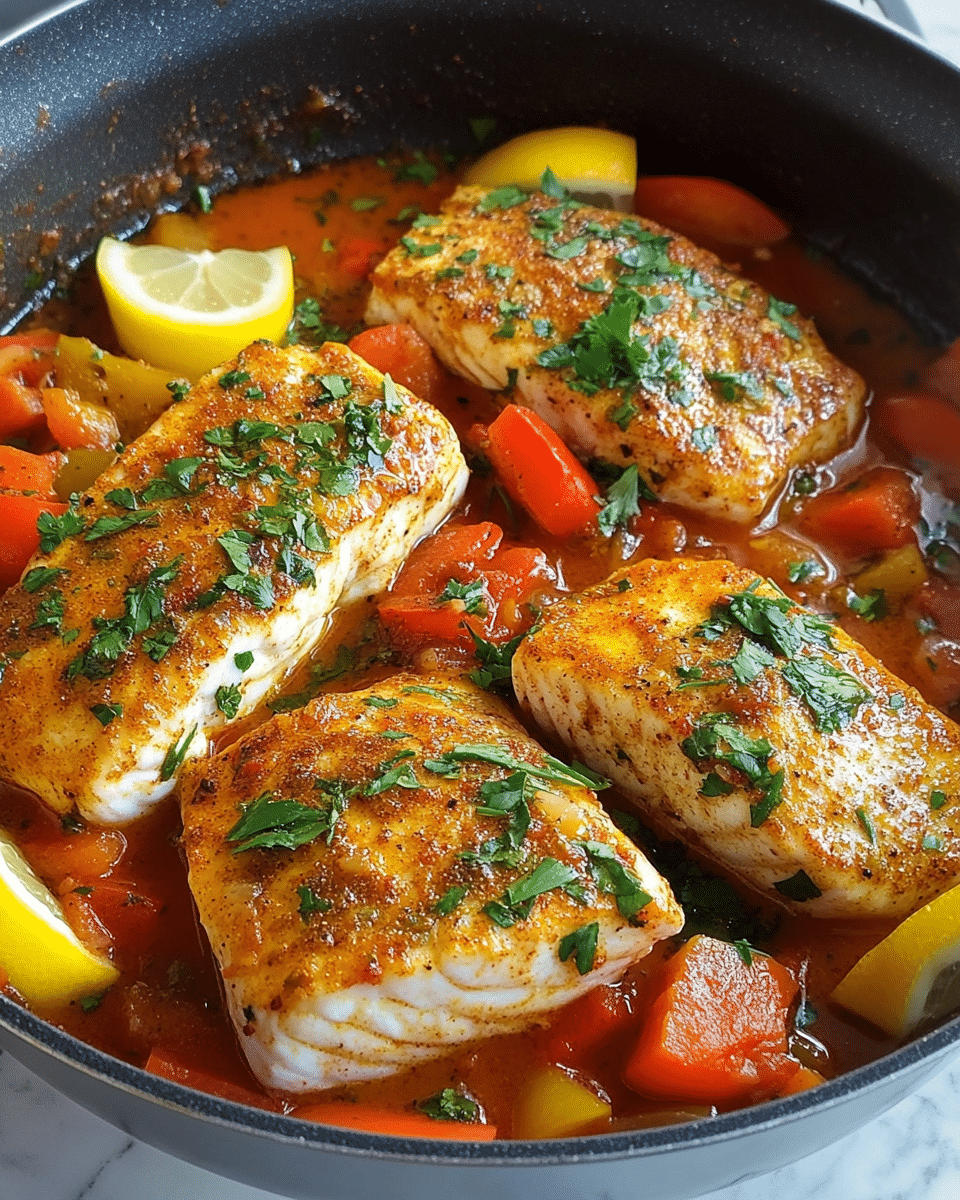The Moroccan Spiced Fish dish is an exciting culinary experience that marries the richness of traditional North African flavors with the lightness of fresh white fish. It’s simmered in a deeply aromatic chermoula marinade a bold blend of parsley, cilantro, garlic, lemon juice, paprika, and cumin that penetrates each bite with mouthwatering zest. Combined with bell peppers and tomatoes, the stew becomes a warming, fragrant plate perfect for lunch or dinner. What makes this dish truly special is its versatility and wholesome nature. It’s naturally gluten-free, low in carbs, and loaded with nutrients from the fish and vegetables. Whether served over a bed of couscous, rice, or just enjoyed on its own with some warm crusty bread, this Moroccan Spiced Fish transforms everyday ingredients into a deeply satisfying and soul-warming dish that’s as impressive to guests as it is comforting for the family table.
Full Recipe:
Ingredients:
-
4 white fish fillets (like cod, halibut, or snapper)
-
1/4 cup olive oil
-
4 garlic cloves, minced
-
1 large red bell pepper, sliced
-
1 large yellow bell pepper, sliced
-
2 ripe tomatoes, chopped
-
1/4 cup fresh parsley, chopped
-
1/4 cup fresh cilantro, chopped
-
Juice of 1 lemon
-
1 tablespoon paprika
-
1 teaspoon ground cumin
-
1/2 teaspoon cayenne pepper
-
Salt and black pepper to taste
-
1/2 cup water
Directions:
-
In a large bowl, mix parsley, cilantro, lemon juice, paprika, cumin, cayenne, salt, and pepper with olive oil to create a marinade (chermoula).
-
Coat the fish fillets in the marinade and let them rest for 20 minutes.
-
In a deep skillet, heat a bit of olive oil and sauté garlic until fragrant.
-
Add bell peppers and tomatoes. Cook until slightly softened.
-
Pour in water and arrange marinated fish fillets on top of the vegetables.
-
Cover and simmer on low heat for 20-25 minutes until the fish is cooked and vegetables are tender.
-
Garnish with extra herbs and lemon slices before serving.
Prep Time: 15 minutes | Cooking Time: 25 minutes | Total Time: 40 minutes
Kcal: 320 kcal | Servings: 4 servings
A Glimpse Into the Richness of Moroccan Cuisine
Moroccan cuisine is a culinary tapestry woven from centuries of cultural fusion. Influenced by Berber, Arab, Mediterranean, and Andalusian traditions, it stands out for its bold spices, rich aromas, and colorful presentation. Among the many standout dishes of this vibrant food culture, Moroccan Spiced Fish typically infused with a marinade called chermoula holds a special place. It represents everything Moroccan cuisine stands for: flavor, warmth, color, and soul.
This dish is a perfect example of how simple ingredients, when treated with care and cultural wisdom, can result in a memorable, aromatic, and nourishing meal. Traditionally served in coastal towns and bustling Moroccan households alike, Moroccan Spiced Fish combines delicate white fish with fiery yet balanced spices and slow-cooked vegetables to create a deeply satisfying culinary experience.
The Secret Behind Chermoula – Morocco’s Quintessential Marinade
At the heart of this dish lies chermoula, a traditional North African marinade bursting with herbs, spices, and citrus. It’s made with fresh parsley, cilantro, garlic, cumin, paprika, lemon juice, and olive oil. Depending on regional and personal preferences, other ingredients like preserved lemon, saffron, or chili paste may be added to intensify its depth.
Chermoula is the soul of Moroccan Spiced Fish. It penetrates the fish, infusing it with a depth of flavor that lingers long after the first bite. This marinade is not just a seasoning it’s a celebration of the Moroccan approach to food, where layers of flavor are thoughtfully built and harmonized.
Why Moroccan Spiced Fish Stands Out
There are many reasons this dish has found favor both in traditional Moroccan homes and with international food lovers:
-
Flavor Complexity: The blend of tangy citrus, earthy cumin, and warm paprika offers a complex yet comforting taste profile that excites the palate.
-
Health Benefits: It’s naturally gluten-free, low in carbs, and packed with lean protein and heart-healthy fats from olive oil and fish.
-
Color and Presentation: With bright peppers, ripe tomatoes, and fresh herbs, the dish is visually as striking as it is delicious.
-
Cultural Authenticity: Cooking Moroccan Spiced Fish is more than a recipe it’s a cultural journey into the heart of North African tradition.
-
Versatility: This dish can be served with couscous, rice, warm flatbread, or even enjoyed on its own. It suits casual family dinners just as well as more formal dining occasions.
Choosing the Right Fish
One of the great things about Moroccan Spiced Fish is its adaptability. While white fish fillets like cod, snapper, or halibut are commonly used, you can also make it with whole fish for a more traditional presentation. The key is to use a firm, mild-tasting fish that can hold its shape during cooking while absorbing the flavors of the marinade.
For those near the sea or who have access to fresh seafood markets, local catch of the day can be used for an even more regional flair. Freshness is essential to balance the bold spices and to ensure a pleasant texture and taste.
Cooking Technique and Layering of Flavor
What sets Moroccan Spiced Fish apart from other spiced seafood dishes is the method of preparation. After marinating, the fish is typically layered over a bed of sautéed vegetables like tomatoes, bell peppers, and onions in a shallow pot or deep skillet. The ingredients are simmered together, often with a splash of water or broth, allowing the flavors to meld and the fish to cook gently until tender.
This slow-cooking technique allows the spices to bloom and the vegetables to soften into a stew-like base. The final result is not just a fish dish but a well-rounded entrée where every bite is packed with complexity.
Pairing Suggestions: From Bread to Beverages
To enjoy Moroccan Spiced Fish the traditional way, pair it with:
-
Couscous: The quintessential Moroccan side. It absorbs the sauce beautifully.
-
Crusty Bread: Ideal for scooping up the spicy juices and tender vegetables.
-
Rice or Bulgur: Great for a more filling meal.
-
Fresh Salads: Think cucumber, mint, and tomato with a lemon dressing to cut the richness.
For beverages, a cool mint tea or even a chilled cucumber yogurt drink can provide a refreshing counterbalance to the warmth of the dish.
Ideal Occasions for Serving Moroccan Spiced Fish
While this dish is rustic and homey enough for everyday dinners, it also shines at special gatherings. Whether you’re planning a themed dinner night, celebrating Ramadan, or simply hosting friends who love global flavors, Moroccan Spiced Fish makes a fantastic centerpiece.
You can also prepare it ahead of time and gently reheat, as the flavors deepen beautifully with a bit of rest. This makes it convenient for entertaining or meal prepping.
Health and Dietary Benefits
Moroccan Spiced Fish is a nutritionally balanced dish. It’s high in:
-
Lean Protein: Essential for muscle repair and satiety.
-
Healthy Fats: Thanks to olive oil and fatty fish options.
-
Vitamins and Minerals: From fresh vegetables and herbs.
-
Antioxidants: Paprika, garlic, and parsley all contain beneficial compounds that support health.
Plus, since it’s free of gluten and dairy, it’s a great option for those with food sensitivities.
Cultural Significance and Heritage
Beyond its culinary merits, this dish carries cultural weight. In Moroccan households, fish is often cooked on Fridays, which are considered a special day in Islamic tradition. The dish reflects not only the geography of Morocco—where Mediterranean and Atlantic coasts provide a bounty of seafood but also its historical trade routes that introduced spices and techniques from across the Arab world and beyond.
Preparing this dish at home is a wonderful way to connect with a rich culinary tradition and pay homage to a food culture that prizes both flavor and hospitality.
Conclusion:
Moroccan Spiced Fish is more than just a tasty seafood option it’s a celebration of culture, flavor, and nutrition. With its vibrant colors, bold spices, and wholesome ingredients, it brings the warmth of North African kitchens into your home. Whether you’re a seasoned cook or a culinary explorer just beginning your global food journey, this dish is approachable, customizable, and unforgettable.






